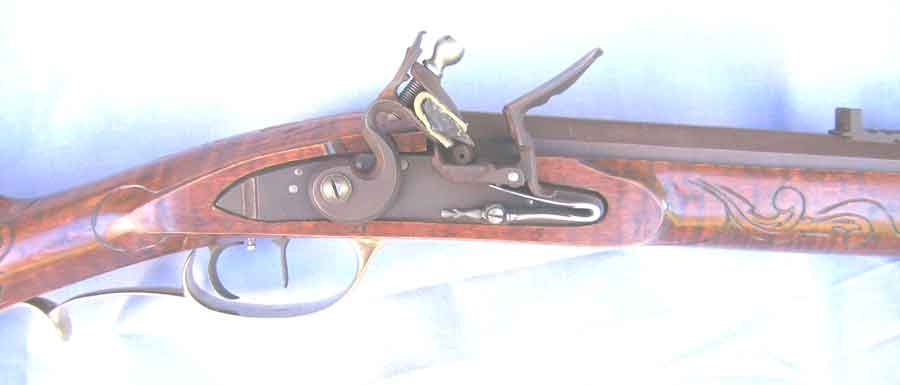SORRY, THIS SERVICE DISCONTINUED FOR NOW I have long been fascinated by the flintlock. How such a mechanism was ever devised is beyond me. Yet its history shows that the process was one of progressive development, from a smoldering ‘match’ applied by hand to a touch-hole, to the same ‘match’ in a ‘cock’, so called because the rooster-like match holder pecked at the priming powder containing pan, to the wheel-lock, the various pecking locks, the miquillette, the snap-haunce and finally the ‘true’ or French flintlock as we know it today. It’s development took about 200 years, it lasted as a predominant means of lighting the fire in a gun for the next 400 years, It is a marvelous means of producing fire.
I have long been fascinated by the flintlock. How such a mechanism was ever devised is beyond me. Yet its history shows that the process was one of progressive development, from a smoldering ‘match’ applied by hand to a touch-hole, to the same ‘match’ in a ‘cock’, so called because the rooster-like match holder pecked at the priming powder containing pan, to the wheel-lock, the various pecking locks, the miquillette, the snap-haunce and finally the ‘true’ or French flintlock as we know it today. It’s development took about 200 years, it lasted as a predominant means of lighting the fire in a gun for the next 400 years, It is a marvelous means of producing fire.
“Marvelous” is a quantitative term. The fire produced depends in great part on the size and number of sparks produced, which in turn depends of the firmness of strike by the flint and the hardness of the frizzen. Both need to be just right. And herein lies the problem. Many mainsprings are not snappy enough to get the job done and many frizzens are not hard enough to splinter off the huge sparks that guarantee a quick shot.
Modern flintlocks are a bit better than the antiques. Spring and frizzens can be manufactured from proper steels (they are not the same) that are supplied by number, the number indicating the qualities of the steel. They can then be tempered using standardized processes that almost always work. Almost, that is. It is the ones that don”t work that interest us.
Because of the problem, White Muzzleloading has decided to offer a frizzen hardening service. Send us your undependable flintlock and we will properly harden the frizzen. Results are not guaranteed, but if the frizzen does not improve substantially with our ministrations we will not charge you for the work. (S&H is not covered- that is your responsibility- both directions) The frizzen will never come back to you in worse shape than it started. However, if the frizzen breaks despite my best work, there is no guarantee. Breakage of the frizzen is always at your risk. That said, I’ve never had one break, but I guess your’s could be the first.
Final results will depend to a great degree on the metal in the frizzen. Common iron is impossible and the frizzen will need to be half-soled, at extra cost. Steel is better, in general the more carbon the better, but too much carbon can make the steel too brittle to hold up to repeated strikes. The goal is to harden the frizzen just right, then draw the tail just right so it will hold up. We think we are pretty good at this, but it is an art, and the results are variable, sometimes disappointing.
The cost is $50 plus S&H. Send in the entire lock, not just the frizzen. Turnaround time can extend to several months.
We can also work on your spring, if that is the problem, and often it’s a big part of the problem. It’s important that the steel in the spring be exactly the right stuff, or re-heat-treating it is of no use. In this case, there is no guarantee , as the spring will not reveal its strength and springiness until it is re-heat-treated. If it’s still too soft, that’s too bad. The charge still applies. Yes, and you might have to buy a new spring if it won’t take. If I break the spring, I won’t charge for the work, but I won’t pay for it or replace it either. Breakage is your risk, but I promise to do the best work I can to get it right. Normally I start from soft and work up. Sometimes it takes two or three tries to get the spring just right. Charge is $30.
We can also tune the lock, adjust springs and interfaces, harden other parts like the tumbler etc, for best performance. This can turn out to be a complex procedure, so the basic charge will be $50. If it too tough, I will contact you with further charges before I do the work.
Order all three, frizzen, spring and tune- for $120. Send no money, just the entire lock and what you want done. I will evaluate it, and let you know if the fix is feasable and what it will cost. Send money only after I am done with it.
